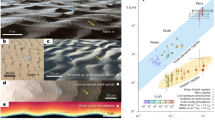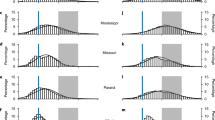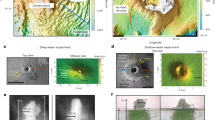Abstract
Subaqueous and aeolian bedforms are ubiquitous on Earth and other planetary environments. However, it is still unclear which hydrodynamic mechanisms lead to the observed variety of morphologies of self-organized natural patterns such as ripples, dunes or compound bedforms. Here we present simulations with a coupled hydrodynamic and sediment transport model that resolve the initial and mature stages of subaqueous and aeolian bedform evolution in the limit of large flow thickness. We identify two types of bedforms consistent with subaqueous ripples and dunes, and separated by a gap in wavelength. This gap is explained in terms of an anomalous hydrodynamic response in the structure of the inner boundary layer that leads to a shift of the position of the maximum shear stress from upstream to downstream of the crest. This anomaly gradually disappears when the bed becomes hydrodynamically rough. By also considering the effect of the spatial relaxation of sediment transport we provide a new unifying framework to compare ripples and dunes in planetary environments to their terrestrial counterparts.
This is a preview of subscription content, access via your institution
Access options
Access Nature and 54 other Nature Portfolio journals
Get Nature+, our best-value online-access subscription
$29.99 / 30 days
cancel any time
Subscribe to this journal
Receive 12 print issues and online access
$259.00 per year
only $21.58 per issue
Buy this article
- Purchase on Springer Link
- Instant access to full article PDF
Prices may be subject to local taxes which are calculated during checkout





Similar content being viewed by others
Code availability
The code that integrates the model equations used for this study can be made available upon request from the authors.
Data availability
The authors declare that the data supporting the findings of this study are within the corresponding references and available from the authors upon request. Some of the data is also within the Supplementary Information file.
References
Sauermann, G., Kroy, K. & Herrmann, H. J. Continuum saltation model for sand dunes. Phys. Rev. E 64, 031305 (2001).
Kroy, K., Sauermann, G. & Herrmann, H. J. Minimal model for sand dunes. Phys. Rev. Lett. 88, 054301 (2002).
Andreotti, B., Claudin, P. & Douady, S. Selection of dune shapes and velocities part 2: a two-dimensional modelling. Eur. Phys. J. B 28, 341–352 (2002).
Fourrière, A., Claudin, P. & Andreotti, B. Bedforms in a turbulent stream: formation of ripples by primary linear instability and of dunes by nonlinear pattern coarsening. J. Fluid Mech. 649, 287–287 (2010).
Colombini, M. & Stocchino, a Ripple and dune formation in rivers. J. Fluid Mech. 673, 121–131 (2011).
Durán, O., Claudin, P. & Andreotti, B. On aeolian transport: grain-scale interactions, dynamical mechanisms and scaling laws. Aeolian Res. 3, 243–270 (2011).
Charru, F., Andreotti, B. & Claudin, P. Sand ripples and dunes. Ann. Rev. Fluid Mech. 45, 469–493 (2013).
Bourke, M. C. et al. Extraterrestrial dunes: an introduction to the special issue on planetary dune systems. Geomorphology 121, 1–14 (2010).
Diniega, S. et al. Our evolving understanding of aeolian bedforms, based on observation of dunes on different worlds. Aeolian Res. 26, 5–27 (2017).
Jia, P., Andreotti, B. & Claudin, P. Giant ripples on comet 67p/Churyumov–Gerasimenko sculpted by sunset thermal wind. Proc. Natl Acad. Sci. USA 114, 2509–2514 (2017).
Silvestro, S., Fenton, L. K., Vaz, D. A., Bridges, N. T. & Ori, G. G. Ripple migration and dune activity on Mars: evidence for dynamic wind processes. Geophys. Res. Lett. 37, L20203 (2010).
Durán, O., Claudin, P. & Andreotti, B. Direct numerical simulations of aeolian sand ripples. Proc. Natl Acad. Sci. USA 111, 15665–15668 (2014).
Silvestro, S., Vaz, D. A., Yizhaq, H. & Esposito, F. Dune-like dynamic of Martian aeolian large ripples: longitudinal large ripples on mars. Geophys. Res. Lett. 43, 8384–8389 (2016).
Lapotre, M. G. A. et al. Large wind ripples on Mars: a record of atmospheric evolution. Science 353, 55–58 (2016).
Yalin, M. On the determination of ripple geometry. J. Hydraul. Eng. 111, 1148–1155 (1985).
Ashley, G. Classification of large-scale subaqueous bedforms: a new look at an old problem—SEPM bedforms and bedding structures. J. Sediment. Res. 60, 160–172 (1990).
Andreotti, B., Fourrière, A., Ould-Kaddour, F., Murray, B. & Claudin, P. Giant aeolian dune size determined by the average depth of the atmospheric boundary layer. Nature 457, 1120–1123 (2009).
Greeley, R., Marshall, J. R. & Leach, R. N. Microdunes and other aeolian bedforms on Venus: wind tunnel simulations. Icarus 60, 152–160 (1984).
Schwämmle, V. & Herrmann, H. J. A model of Barchan dunes including lateral shear stress. Eur. Phys. J. E 16, 57–65 (2005).
Claudin, P., Durán, O. & Andreotti, B. Dissolution instability and roughening transition. J. Fluid Mech. 832, R2 (2017).
Venditti, J. G., Church, M. & Bennett, S. J. Morphodynamics of small-scale superimposed sand waves over migrating dune bed forms. Water Resour. Res. 41, W10423 (2005).
Venditti, J. G., Church, M. & Bennett, S. J. On interfacial instability as a cause of transverse subcritical bed forms. Water Resour. Res. 42, W07423 (2006).
Richards, K. J. The formation of ripples and dunes on an erodible bed. J. Fluid Mech. 99, 597–618 (1980).
McLean, S. R. The stability of ripples and dunes. Earth Sci. Rev. 29, 131–144 (1990).
Andreotti, B., Claudin, P. & Pouliquen, O. Measurements of the aeolian sand transport saturation length. Geomorphology 123, 343–348 (2010).
Berg, J. H. V. D. & Gelder, A. V. in Alluvial Sedimentation (eds Marzo, M. & Puigdefábregas, C.) 11–21 (Wiley-Blackwell, Hoboken, 1993).
Lapotre, M. G. A. et al. Morphologic diversity of Martian ripples: implications for large-ripple formation. Geophys. Res. Lett. 45, 10,229–10,239 (2018).
Weitz, C. M. et al. Sand grain sizes and shapes in aeolian bedforms at Gale crater, Mars. Geophys. Res. Lett. 45, 9471–9479 (2018).
Hugenholtz, C. H., Barchyn, T. E. & Boulding, A. Morphology of transverse aeolian ridges (TARs) on Mars from a large sample: further evidence of a megaripple origin? Icarus 286, 193–201 (2017).
Geissler, P. E. & Wilgus, J. T. The morphology of transverse aeolian ridges on Mars. Aeolian Res. 26, 63–71 (2017).
Claudin, P. & Andreotti, B. A scaling law for aeolian dunes on Mars, Venus, Earth, and for subaqueous ripples. Earth Planet. Sci. Lett. 252, 30–44 (2006).
Sullivan, R. et al. Wind-driven particle mobility on Mars: insights from Mars Exploration Rover observations at ‘El Dorado’ and surroundings at Gusev Crater. J. Geophys. Res. 113, E06S07 (2008).
Bridges, N. T., Spagnuolo, M. G., de Silva, S. L., Zimbelman, J. R. & Neely, E. M. Formation of gravel-mantled megaripples on Earth and Mars: insights from the Argentinean Puna and wind tunnel experiments. Aeolian Res. 17, 49–60 (2015).
Abrams, J. & Hanratty, T. J. Relaxation effects observed for turbulent flow over a wavy surface. J. Fluid Mech. 151, 443–455 (1985).
Frederick, K. A. & Hanratty, T. J. Velocity measurements for a turbulent nonseparated flow over solid waves. Exp. Fluids 6, 477–486 (1988).
Southard, J. B. & Boguchwal, L. A. Bed configurations in steady unidirectional water flows. Part 2: synthesis of flume data. J. Sediment. Petrol. 60, 658–679 (1990).
Baas, J. H., Best, J. L. & Peakall, J. Predicting bedforms and primary current stratification in cohesive mixtures of mud and sand. J. Geol. Soc. 173, 12–45 (2016).
Andreotti, B., Claudin, P., Devauchelle, O., Durán, O. & Fourrière, A. Bedforms in a turbulent stream: ripples, chevrons and antidunes. J. Fluid Mech. 690, 94–128 (2012).
Lämmel, M. et al. Aeolian sand sorting and megaripple formation. Nat. Phys. 14, 759–765 (2018).
Andreotti, B., Claudin, P. & Pouliquen, O. Aeolian sand ripples: experimental study of fully developed states. Phys. Rev. Lett. 96, 028001 (2006).
Marshall, J. R. & Greeley, R. An experimental study of aeolian structures on Venus. J. Geophys. Res. Planets 97, 1007–1016 (1992).
Durán, O., Andreotti, B. & Claudin, P. Numerical simulation of turbulent sediment transport, from bed load to saltation. Phys. Fluids 24, 103306 (2012).
Ungar, J. E. & Haff, P. K. Steady state saltation in air. Sedimentology 34, 289–299 (1987).
Pähtz, T., Kok, J. F., Parteli, E. J. R. & Herrmann, H. J. Flux saturation length of sediment transport. Phys. Rev. Lett. 111, 218002 (2013).
Pähtz, T. & Durán, O. Fluid forces or impacts: what governs the entrainment of soil particles in sediment transport mediated by a Newtonian fluid? Phys. Rev. Fluids 2, 074303 (2017).
Sullivan, R. & Kok, J. F. Aeolian saltation on Mars at low wind speeds. J. Geophys. Res. Planets 122, 2111–2143 (2017).
Pont, S. Cd, Narteau, C. & Gao, X. Two modes for dune orientation. Geology 42, 743–746 (2014).
Guy, H. P., Simons, D. B. & Richardson, E. V. Summary of Alluvial Channel Data from Flume Experiments, 1956–61 (US Government Printing Office, 1966).
Martin, R. L. & Jerolmack, D. J. Origin of hysteresis in bed form response to unsteady flows. Water Resour. Res. 49, 1314–1333 (2013).
Baas, J. H. A flume study on the development and equilibrium morphology of current ripples in very fine sand. Sedimentology 41, 185–209 (1994).
Baas, J. H. An empirical model for the development and equilibrium morphology of current ripples in fine sand. Sedimentology 46, 123–138 (1999).
Langlois, V. & Valance, A. Initiation and evolution of current ripples on a flat sand bed under turbulent water flow. Eur. Phys. J. E 22, 201–208 (2007).
Coleman, S. E. & Melville, B. W. Initiation of bed forms on a flat sand bed. J. Hydraul. Eng. 122, 301–310 (1996).
Kuru, W. C., Leighton, D. T. & McCready, M. J. Formation of waves on a horizontal erodible bed of particles. Int. J. Multiphase Flow 21, 1123–1140 (1995).
Jain, S. C. & Kennedy, J. F. The growth of sand waves. In Proc. Int. Symp. Stochastic Hydraul. 449–471 (Pittsburgh University Press, Pittsburgh, 1971)..
Jain, S. C. & Kennedy, J. F. The spectral evolution of sedimentary bed forms. J. Fluid Mech. 63, 301–314 (1974).
Nakagawa, H. & Tsujimoto, T. Spectral analysis of sand bed instability. J. Hydraul. Eng. 110, 467–483 (1984).
Bridge, J. S. & Best, J. L. Flow, sediment transport and bedform dynamics over the transition from dunes to upper-stage plane beds: implications for the formation of planar laminae. Sedimentology 35, 753–763 (1988).
Greeley, R. et al. Windblown sand on Venus: preliminary results of laboratory simulations. Icarus 57, 112–124 (1984).
Kok, J. F. Difference in the wind speeds required for initiation versus continuation of sand transport on Mars: implications for dunes and dust storms. Phys. Rev. Lett. 104, 074502 (2010).
Newman, C. E. et al. Winds measured by the Rover Environmental Monitoring Station (REMS) during the Mars Science Laboratory (MSL) Rover’s Bagnold Dunes Campaign and comparison with numerical modeling using MarsWRF. Icarus 291, 203–231 (2017).
Acknowledgements
O.D.V. and C.W. were funded through the DFG Research Center/Cluster of Excellence ‘The Ocean in the Earth System’.
Author information
Authors and Affiliations
Contributions
O.D.V. and C.W. contributed to the conception of the work and the analysis of bedform data. O.D.V. performed the simulations. O.D.V, B.A. and P.C. contributed to the validation of the model, interpretation of the results and writing of the manuscript.
Corresponding author
Ethics declarations
Competing interests
The authors declare no competing interests.
Additional information
Publisher’s note: Springer Nature remains neutral with regard to jurisdictional claims in published maps and institutional affiliations.
Supplementary information
Supplementary Information
Supplementary methods, supplementary figures, supplementary references
Supplementary Movie 1
Temporal evolution of simulated subaqueous bedforms. Simulation for Rd=3 and u∗/ut=2.2, corresponding to stable ripples (Fig. 1a).
Supplementary Movie 2
Temporal evolution of simulated subaqueous bedforms. Simulation for Rd=10 and u∗/ut=2.5, corresponding to dunes with superimposed stable ripples (Fig. 1b)
Supplementary Movie 3
Temporal evolution of simulated subaqueous bedforms. Simulation for Rd=35 and u∗/ut=4.2, corresponding to dunes without ripples (Fig. 1c)
Rights and permissions
About this article
Cite this article
Duran Vinent, O., Andreotti, B., Claudin, P. et al. A unified model of ripples and dunes in water and planetary environments. Nat. Geosci. 12, 345–350 (2019). https://doi.org/10.1038/s41561-019-0336-4
Received:
Accepted:
Published:
Issue Date:
DOI: https://doi.org/10.1038/s41561-019-0336-4
This article is cited by
-
Coevolving aerodynamic and impact ripples on Earth
Nature Geoscience (2024)
-
Raising dikes and managed realignment may be insufficient for maintaining current flood risk along the German Baltic Sea coast
Communications Earth & Environment (2023)
-
Megaripple mechanics: bimodal transport ingrained in bimodal sands
Nature Communications (2022)
-
A distinct ripple-formation regime on Mars revealed by the morphometrics of barchan dunes
Nature Communications (2022)
-
Probing space to understand Earth
Nature Reviews Earth & Environment (2020)



